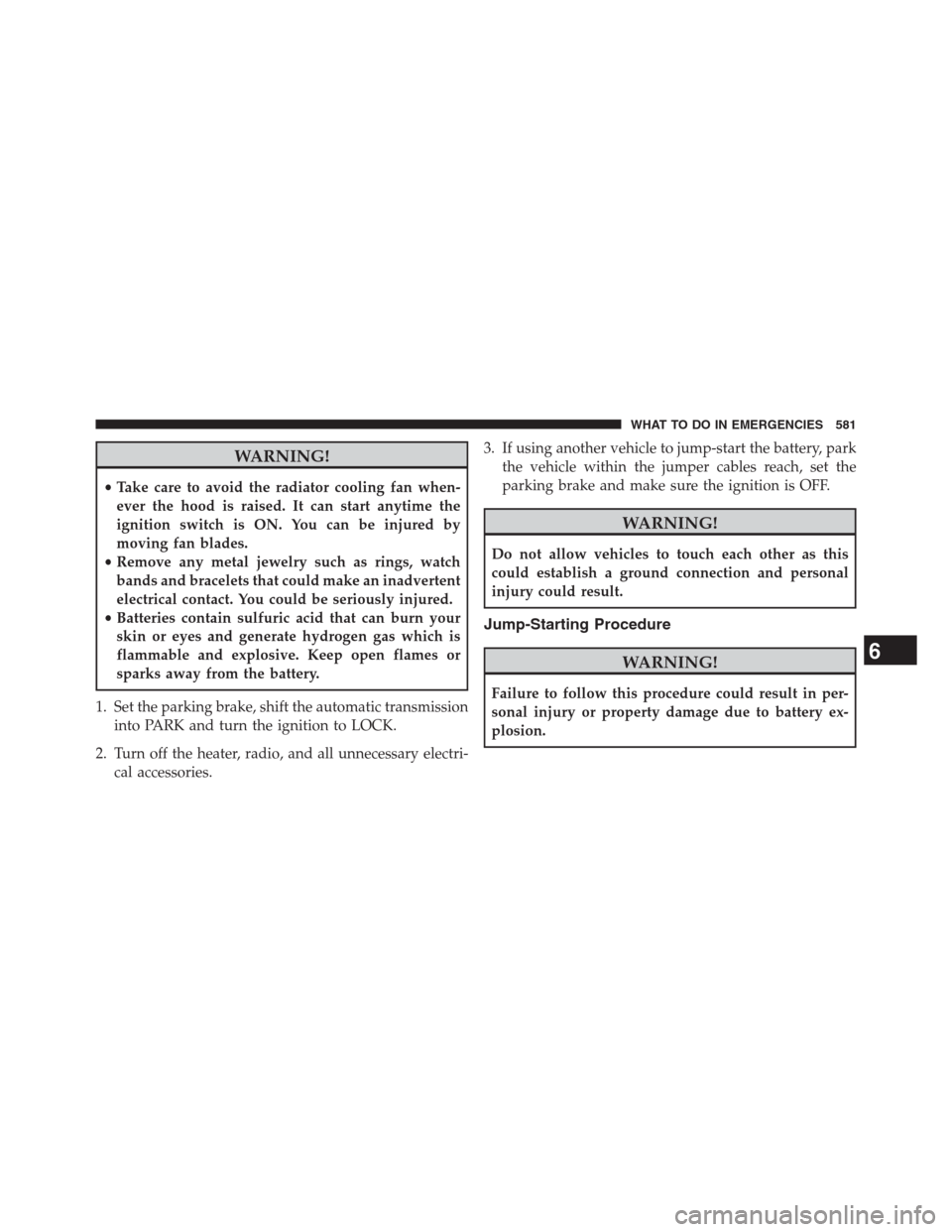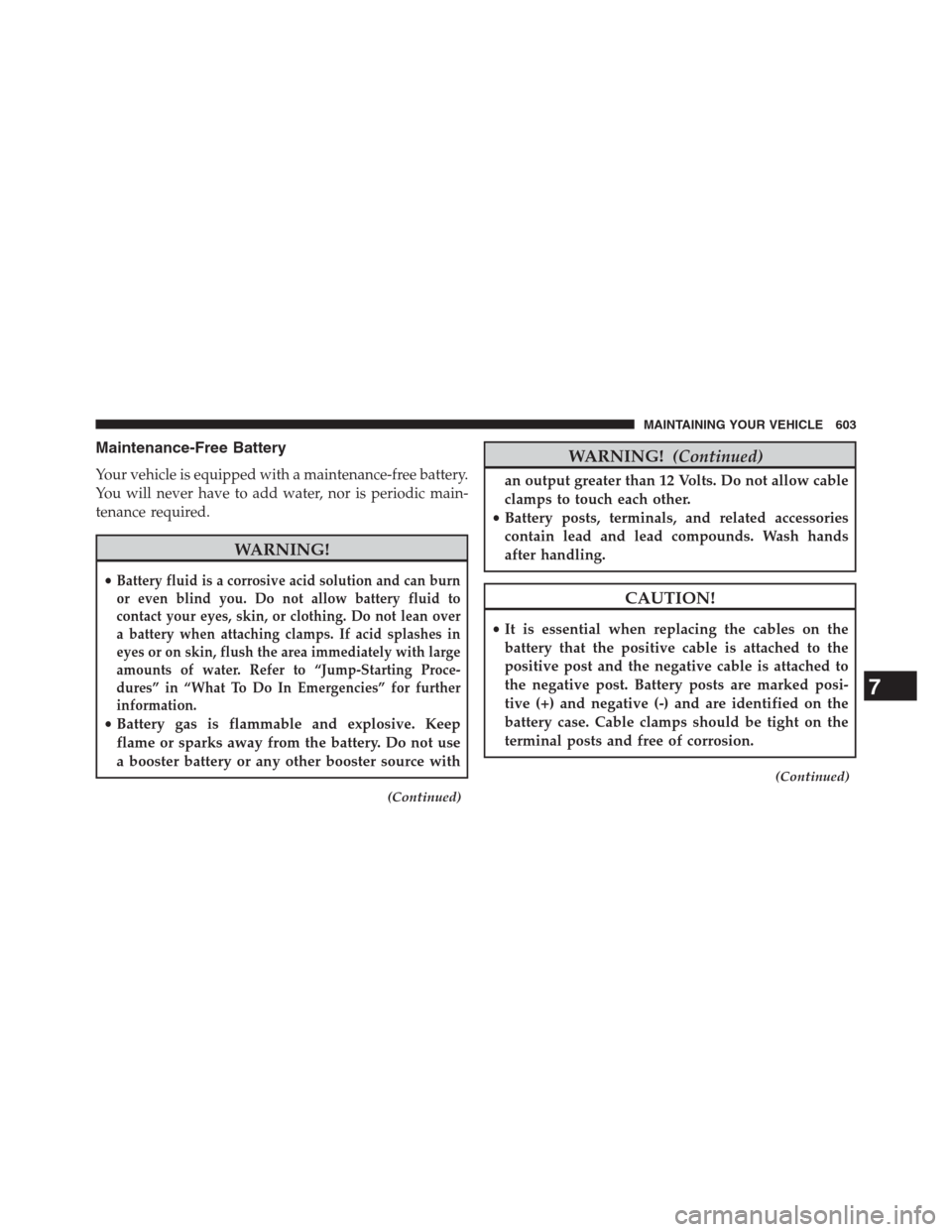Page 581 of 683

WARNING!
To avoid the risk of forcing the vehicle off the jack,
do not tighten the wheel nuts fully until the vehicle
has been lowered. Failure to follow this warning may
result in personal injury.
3. Lower the vehicle to the ground by turning the jack
handle counterclockwise.
4.
Finish tightening the lug nuts. Push down on the
wrench while at the end of the handle for increased
leverage. Tighten the lug nuts in a star pattern until each
nut has been tightened twice. The correct tightness of
each lug nut is 100 ft/lbs (135 N·m). If in doubt about
the correct tightness, have them checked with a torque
wrench by your authorized dealer or service station.
5. After 25 miles (40 km) check the lug nut torque with a
torque wrench to ensure that all lug nuts are properly
seated against the wheel.
JUMP-STARTING
If your vehicle has a discharged battery it can be jump-
started using a set of jumper cables and a battery in
another vehicle or by using a portable battery booster
pack. Jump-starting can be dangerous if done improperly
so please follow the procedures in this section carefully.
NOTE:When using a portable battery booster pack
follow the manufacturer ’s operating instructions and
precautions.
CAUTION!
Do not use a portable battery booster pack or any
other booster source with a system voltage greater
than 12 Volts or damage to the battery, starter motor,
alternator or electrical system may occur.
6
WHAT TO DO IN EMERGENCIES 579
Page 582 of 683
WARNING!
Do not attempt jump-starting if the battery is frozen.
It could rupture or explode and cause personal injury.
Preparations For Jump-Start
The battery in your vehicle is located on the left side of
the engine compartment.
Positive Battery Post
580 WHAT TO DO IN EMERGENCIES
Page 583 of 683

WARNING!
•Take care to avoid the radiator cooling fan when-
ever the hood is raised. It can start anytime the
ignition switch is ON. You can be injured by
moving fan blades.
•Remove any metal jewelry such as rings, watch
bands and bracelets that could make an inadvertent
electrical contact. You could be seriously injured.
•Batteries contain sulfuric acid that can burn your
skin or eyes and generate hydrogen gas which is
flammable and explosive. Keep open flames or
sparks away from the battery.
1. Set the parking brake, shift the automatic transmission
into PARK and turn the ignition to LOCK.
2. Turn off the heater, radio, and all unnecessary electri-
cal accessories.3. If using another vehicle to jump-start the battery, park
the vehicle within the jumper cables reach, set the
parking brake and make sure the ignition is OFF.
WARNING!
Do not allow vehicles to touch each other as this
could establish a ground connection and personal
injury could result.
Jump-Starting Procedure
WARNING!
Failure to follow this procedure could result in per-
sonal injury or property damage due to battery ex-
plosion.
6
WHAT TO DO IN EMERGENCIES 581
Page 584 of 683

CAUTION!
Failure to follow these procedures could result in
damage to the charging system of the booster vehicle
or the discharged vehicle.
1. Connect the positive(+)end of the jumper cable to the
positive(+)post of the discharged vehicle.
2. Connect the opposite end of the positive(+)jumper
cable to the positive(+)post of the booster battery.
3. Connect the negative end(-)of the jumper cable to the
negative(-)post of the booster battery.
4. Connect the opposite end of the negative(-)jumper
cable to a good engine ground (exposed metal part of
the discharged vehicle’s engine) away from the battery
and the fuel injection system.
WARNING!
Do not connect the cable to the negative post (-) of the
discharged battery. The resulting electrical spark
could cause the battery to explode and could result in
personal injury.
5. Start the engine in the vehicle that has the booster
battery, let the engine idle a few minutes, and then
start the engine in the vehicle with the discharged
battery. Once the engine is started, remove the jumper
cables in the reverse sequence:
6. Disconnect the negative(-)jumper cable from the
negative(-)post of the vehicle with the discharged
battery.
7. Disconnect the negative end(-)of the jumper cable
from the negative(-)post of the booster battery.
582 WHAT TO DO IN EMERGENCIES
Page 585 of 683

8. Disconnect the opposite end of the positive(+)jumper
cable from the positive(+)post of the booster battery.
9. Disconnect the positive(+)end of the jumper cable
from the positive(+)post of the discharged vehicle.
If frequent jump-starting is required to start your vehicle
you should have the battery and charging system in-
spected at your authorized dealer.
CAUTION!
Accessories plugged into the vehicle power outlets
draw power from the vehicle’s battery, even when not
in use (i.e., cellular phones, etc.). Eventually, if
plugged in long enough without engine operation,
the vehicle’s battery will discharge sufficiently to
degrade battery life and/or prevent the engine from
starting.
FREEING A STUCK VEHICLE
If your vehicle becomes stuck in mud, sand or snow, it
can often be moved using a rocking motion. Turn the
steering wheel right and left to clear the area around the
front wheels. Then shift back and forth between DRIVE
and REVERSE while gently pressing the accelerator. Use
the least amount of accelerator pedal pressure that will
maintain the rocking motion, without spinning the
wheels or racing the engine.
CAUTION!
Racing the engine or spinning the wheels may lead to
transmission overheating and failure. Allow the en-
gine to idle with the transmission in NEUTRAL for at
least one minute after every five rocking-motion
cycles. This will minimize overheating and reduce
the risk of transmission failure during prolonged
efforts to free a stuck vehicle.
6
WHAT TO DO IN EMERGENCIES 583
Page 605 of 683

Maintenance-Free Battery
Your vehicle is equipped with a maintenance-free battery.
You will never have to add water, nor is periodic main-
tenance required.
WARNING!
•Battery fluid is a corrosive acid solution and can burn
or even blind you. Do not allow battery fluid to
contact your eyes, skin, or clothing. Do not lean over
a battery when attaching clamps. If acid splashes in
eyes or on skin, flush the area immediately with large
amounts of water. Refer to “Jump-Starting Proce-
dures” in “What To Do In Emergencies” for further
information.
•Battery gas is flammable and explosive. Keep
flame or sparks away from the battery. Do not use
a booster battery or any other booster source with
(Continued)
WARNING!(Continued)
an output greater than 12 Volts. Do not allow cable
clamps to touch each other.
•Battery posts, terminals, and related accessories
contain lead and lead compounds. Wash hands
after handling.
CAUTION!
•It is essential when replacing the cables on the
battery that the positive cable is attached to the
positive post and the negative cable is attached to
the negative post. Battery posts are marked posi-
tive (+) and negative (-) and are identified on the
battery case. Cable clamps should be tight on the
terminal posts and free of corrosion.
(Continued)
7
MAINTAINING YOUR VEHICLE 603
Page 665 of 683

Automatic Transmission....................464
Adding Fluid..........................618
Fluid and Filter Changes..................618
Fluid Change..........................618
Fluid Level Check.......................618
Fluid Type............................617
Gear Ranges...........................469
Special Additives.......................617
Torque Converter.......................476
Auto Up Power Windows....................42
Battery.................................603
Jump Starting..........................579
Keyless Transmitter Replacement (RKE)........28
Saving Feature (Protection)................228
Belts, Seat...............................118
Blind Spot Monitoring......................136
Body Mechanism Lubrication.................607
B-Pillar Location..........................502Brake Assist System.......................487
Brake Control System, Electronic..............486
Brake Fluid.............................640
Brake System............................615
Fluid Check...........................615
Parking..............................481
Warning Light.........................320
Brake/Transmission Interlock.................466
Bulb Replacement.........................635
Bulbs, Light.............................120
Calibration, Compass......................340
Camera, Rear............................249
Capacities, Fluid..........................638
Caps, Filler
Fuel.................................537
Power Steering.........................481
Radiator (Coolant Pressure)................612
Carbon Monoxide Warning
..................11710
INDEX 663
Page 668 of 683

Electrical Power Outlets.....................269
Electric Remote Mirrors.....................133
Electronic Brake Control System...............486
Brake Assist System.....................487
Electronic Speed Control (Cruise Control)........237
Electronic Stability Control (ESC)..............488
Electronic Vehicle Information Center (EVIC)......325
Emergency, In Case of
Hazard Warning Flasher..................560
Jacking...............................561
Jump Starting..........................579
Overheating...........................560
Emission Control System Maintenance..........593
Engine
Air Cleaner...........................599
Block Heater..........................464
Break-In Recommendations................116
Checking Oil Level......................597
Compartment..........................591Compartment Identification................591
Coolant (Antifreeze).....................609
Cooling..............................608
Exhaust Gas Caution.....................117
Flooded, Starting.......................462
Fuel Requirements......................528
Oil..................................597
Oil Selection...........................597
Oil Synthetic..........................598
Overheating...........................560
Starting..............................461
Temperature Gauge......................322
Engine Oil Viscosity.......................598
Engine Oil Viscosity Chart...................598
Enhanced Accident Response Feature............85
Entry System, Illuminated....................20
Ethanol................................529
Event Data Recorder........................88
Exhaust Gas Caution........................55
666 INDEX